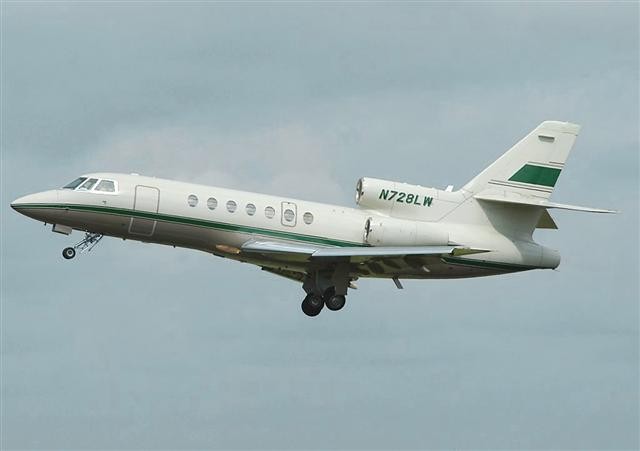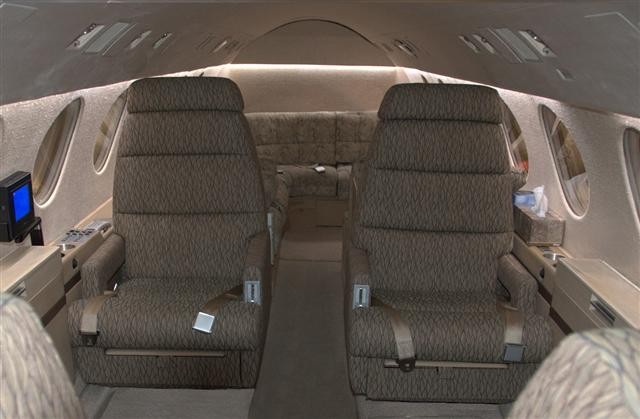


Aircraft Description
The cabin of the Falcon 50 is usually configured to carry eight to ten passengers but can be modified to carry as many as nineteen. It is 5.9 feet high, 23.5 feet long, and 6.1 feet wide for a total cabin volume of 700 cubic feet. The external storage compartment is long enough to fit objects up to eight feet. The cabin of the Falcon 50 is rated to 8.7 psi, and is automatically regulated. A two-zone temperature control system uses bleed air from the center engine to control heat.
The Falcon 50 is one of the rare jets to use a three-engine configuration — in this case, three Honeywell TFE731-3-1C turbofan engines that provide 3,700 pounds of thrust each on takeoff. Each engine has a separate fuel system of about 5,000 pounds for a total fuel capacity of 15,520 pounds – enough to fly seven hours nonstop with fuel reserves. Three hydraulic pumps keep the fuel consumption equal between the three fuel tanks. On average, fuel consumption per hour is between 2,100 and 2,200 pounds.
The runway performance of the Falcon 50 is one of its strong points. The runway requirement at sea level is 4,700 feet. At an elevation of 5,000 feet and a temperature of 77 degrees Fahrenheit, the takeoff distance increases to 7,105 feet. It climbs to 39,000 feet in thirty minutes. At an altitude of 37,000 feet, it can reach its top cruise speed of 468 knots. At 43,000 feet, it can cruise at 410 knots for long-range trips.
The Falcon 50, like an increasing number of advanced midsized private jets, was designed with the help of computer-molded fluid dynamics software. Its wings are designed to minimize drag, even at high speeds. Since roughly half of the noise produced by a private jet in flight comes from the wind impacting a fast-moving structure and meeting resistance, the Falcon 50’s aerodynamic advances help keep it fairly quiet for a private jet of its size. It produces 84.3 EPNdB on takeoff, and 87 EPNdB on flyover.
The cockpit’s avionics system comes standard with an ADC 80 air data computer, a Primus color weather radar, a Collins FCS-80F autopilot computer, and a dual VHF comm. DME, two navigation radios, and a radio altimeter are also included. Additional systems may be added as desired.
Dassault strikes a good balance between range, runway performance, and speed in the Falcon 50. With a cabin measuring more than twenty-three feet long and a transcontinental range, the Falcon 50 still manages to cruise at speeds of 468 knots. Its performance levels are high while other factors, such as its takeoff distance, remain competitive.
| General | Falcon 50, DA-50 | |||
|---|---|---|---|---|
| Category | Jet < 20,000 lbs. | |||
| Years Aircraft Manufactured | 1977 – 1996 | |||
| Serial Number Range | 0001 – 0250, 252 | |||
| Retail High Price | $5,499,000.00 / 4,315,065.30€ | |||
| Retail Low Price | $1,295,000.00 / 1,016,186.50€ | |||
| Characteristics | Falcon 50, DA-50 | |||
| Seating | 2+9/19 | |||
| Wing Loading | 77.0 | |||
| Power Loading | 3.5 | |||
| Noise(EPNdB): Takeoff/Sideline/Approach | 84.3/97.4 | |||
| External Dimensions (ft) | Falcon 50, DA-50 | |||
| External Length | 60.8 | |||
| External Height | 22.9 | |||
| External Span | 61.8 | |||
| Internal Dimensions (ft) | Falcon 50, DA-50 | |||
| Internal Length (Overall/Net Height) | 23.5 | |||
| Internal Height | 5.9 | |||
| Internal Width (Max/Floor) | 6.1/5.2 | |||
| Baggage | Falcon 50, DA-50 | |||
| External: Cu.Ft./Lb. | N/A | |||
| External: Cu.Ft./Lb. | N/A | |||
| Power | Falcon 50, DA-50 | |||
| Engines | 3 Hon TFE731-3-1C | |||
| Output (lbs ea.)/Flat Rating | 3,700 | |||
| Inspection Interval | 4,200c | |||
| Data based on latest manufactured year | ||||



